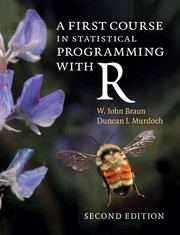Book contents
- Frontmatter
- Contents
- Preface to the second edition
- Preface to the first edition
- 1 Getting started
- 2 Introduction to the R language
- 3 Programming statistical graphics
- 4 Programming with R
- 5 Simulation
- 6 Computational linear algebra
- 7 Numerical optimization
- Appendix Review of random variables and distributions
- Index
Preface to the second edition
Published online by Cambridge University Press: 05 July 2016
- Frontmatter
- Contents
- Preface to the second edition
- Preface to the first edition
- 1 Getting started
- 2 Introduction to the R language
- 3 Programming statistical graphics
- 4 Programming with R
- 5 Simulation
- 6 Computational linear algebra
- 7 Numerical optimization
- Appendix Review of random variables and distributions
- Index
Summary
A lot of things have happened in the R community since we wrote the first edition of this text. Millions of new users have started to use R, and it is now the premier platform for data analytics. (In fact, the term “data analytics” hardly existed when we wrote the first edition.)
RStudio, a cross-platform integrated development environment for R, has had a large influence on the increase in popularity. In this edition we recommend RStudio as the platform for most new users, and have integrated simple RStudio instructions into the text. In fact, we have used RStudio and the knitr package in putting together the manuscript.
We have also added numerous examples and exercises, and cleaned up existing ones when they were unclear. Chapter 2 (Introduction to the R language) has had extensive revision and reorganization. We have added short discussions of newer graphics systems to Chapter 3 (Programming statistical graphics). Reference material on some common error messages has been added to Chapter 4 (Programming with R), and a list of pseudorandom number generators as well as a more extensive discussion of Markov chain Monte Carlo is new in Chapter 5 (Simulation). In Chapter 6 (Computational linear algebra), some applications have been added to give students a better idea of why some of the matrix decompositions are so important. Once again we have a lot of people to thank. Many students have used the first edition, and we are grateful for their comments and criticisms. Some anonymous reviewers also provided some helpful suggestions and pointers so that we could make improvements to the text. We hope our readers find this new edition as interesting and educational as we think it is.
- Type
- Chapter
- Information
- A First Course in Statistical Programming with R , pp. xi - xiiPublisher: Cambridge University PressPrint publication year: 2016

